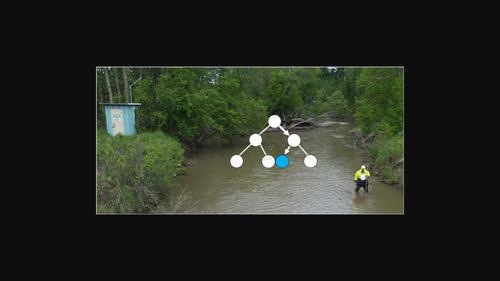当前位置:
X-MOL 学术
›
Hydrol. Process.
›
论文详情
Our official English website, www.x-mol.net, welcomes your feedback! (Note: you will need to create a separate account there.)
Using machine learning to improve predictions and provide insight into fluvial sediment transport
Hydrological Processes ( IF 3.2 ) Pub Date : 2022-07-24 , DOI: 10.1002/hyp.14648 J. William Lund 1, 2 , Joel T. Groten 1 , Diana L. Karwan 2 , Chad Babcock 2
Hydrological Processes ( IF 3.2 ) Pub Date : 2022-07-24 , DOI: 10.1002/hyp.14648 J. William Lund 1, 2 , Joel T. Groten 1 , Diana L. Karwan 2 , Chad Babcock 2
Affiliation

|
A thorough understanding of fluvial sediment transport is critical to addressing many environmental concerns such as exacerbated flooding, degradation of aquatic habitat, excess nutrients, and the economic challenges of restoring aquatic systems. Fluvial sediment samples are integral for addressing these environmental concerns but cannot be collected at every river and time of interest. Therefore, to gain a better understanding for rivers where direct measurements have not been made, extreme gradient boosting machine learning (ML) models were developed and trained to predict suspended sediment and bedload from sampling data collected in Minnesota, United States (U.S.), by the U.S. Geological Survey. Approximately 400 watershed (full upstream area), catchment (nearby landscape), near-channel, channel, and streamflow features were retrieved or developed from multiple sources, reduced to approximately 30 uncorrelated features, and used in the final ML models. The results indicate suspended sediment and bedload ML models explain approximately 70% of the variance in the datasets. Important features used in the models were interpreted with Shapley additive explanation (SHAP) plots, which provided insight into sediment transport processes. The most important features in the models were developed to normalize streamflow by the 2-year recurrence interval and quantify the rate of change in streamflow (slope), which helped account for sediment hysteresis. Generally, this study also showed a combination of mostly watershed and catchment geospatial features were important in ML models that predict sediment transport from physical samples. This study is a promising step forward in making fluvial sediment transport predictions using machine learning models trained by physically collected samples. The approach developed here can be used wherever similar datasets exists and will be useful for landscape and water management.
中文翻译:

使用机器学习来改进预测并提供对河流沉积物输送的洞察力
全面了解河流沉积物迁移对于解决许多环境问题至关重要,例如洪水加剧、水生栖息地退化、营养过剩以及恢复水生系统的经济挑战。河流沉积物样本对于解决这些环境问题是不可或缺的,但不能在每条河流和感兴趣的时间收集。因此,为了更好地了解尚未进行直接测量的河流,开发并训练了极端梯度提升机器学习 (ML) 模型,以根据在美国明尼苏达州 (US) 收集的采样数据预测悬浮沉积物和床载,由美国地质调查局。大约 400 个流域(全上游区域)、集水区(附近景观)、近河道、河道、从多个来源检索或开发流特征,减少到大约 30 个不相关的特征,并用于最终的 ML 模型。结果表明悬浮沉积物和床载 ML 模型解释了数据集中大约 70% 的方差。模型中使用的重要特征通过 Shapley 加性解释 (SHAP) 图进行解释,从而深入了解沉积物迁移过程。模型中最重要的特征是按照 2 年的重复间隔对水流进行标准化,并量化水流(坡度)的变化率,这有助于解释沉积物滞后现象。一般来说,这项研究还表明,流域和集水区地理空间特征的组合在预测物理样本沉积物迁移的 ML 模型中很重要。这项研究是使用由物理收集样本训练的机器学习模型进行河流沉积物输送预测的有希望的一步。此处开发的方法可用于存在类似数据集的任何地方,并将对景观和水管理有用。
更新日期:2022-07-24
中文翻译:

使用机器学习来改进预测并提供对河流沉积物输送的洞察力
全面了解河流沉积物迁移对于解决许多环境问题至关重要,例如洪水加剧、水生栖息地退化、营养过剩以及恢复水生系统的经济挑战。河流沉积物样本对于解决这些环境问题是不可或缺的,但不能在每条河流和感兴趣的时间收集。因此,为了更好地了解尚未进行直接测量的河流,开发并训练了极端梯度提升机器学习 (ML) 模型,以根据在美国明尼苏达州 (US) 收集的采样数据预测悬浮沉积物和床载,由美国地质调查局。大约 400 个流域(全上游区域)、集水区(附近景观)、近河道、河道、从多个来源检索或开发流特征,减少到大约 30 个不相关的特征,并用于最终的 ML 模型。结果表明悬浮沉积物和床载 ML 模型解释了数据集中大约 70% 的方差。模型中使用的重要特征通过 Shapley 加性解释 (SHAP) 图进行解释,从而深入了解沉积物迁移过程。模型中最重要的特征是按照 2 年的重复间隔对水流进行标准化,并量化水流(坡度)的变化率,这有助于解释沉积物滞后现象。一般来说,这项研究还表明,流域和集水区地理空间特征的组合在预测物理样本沉积物迁移的 ML 模型中很重要。这项研究是使用由物理收集样本训练的机器学习模型进行河流沉积物输送预测的有希望的一步。此处开发的方法可用于存在类似数据集的任何地方,并将对景观和水管理有用。



























 京公网安备 11010802027423号
京公网安备 11010802027423号